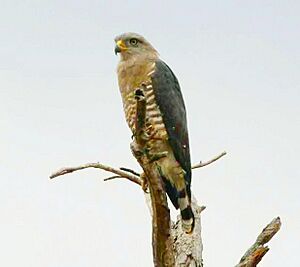Southern banded snake eagle facts for kids
Quick facts for kids Southern banded snake eagle |
|
|---|---|
 |
|
| Individual in Sofala, Mozambique | |
| Conservation status | |
| Scientific classification |
The southern banded snake eagle (Circaetus fasciolatus) is a special type of snake eagle. It's also known as the East African snake eagle or fasciated snake eagle. This bird of prey lives in eastern Sub-Saharan Africa. It's part of the Accipitridae family, which includes many birds like hawks and eagles.
Contents
About the Southern Banded Snake Eagle
The southern banded snake eagle is a fairly small and strong bird. It has a big, round head and a hooked beak. Its head is grey-brown, which stands out a bit from its dark brown upper body. Its belly and chest are whitish.
What It Looks Like
This eagle's tail has a white tip. You can see three clear dark bands on the underside of its tail. It has large, pale yellow eyes. Its feet and the skin around its beak (called the cere) are yellow. Its beak is black.
Young southern banded snake eagles look a bit different. They don't have the grey head. Their upper body is mostly dark. Their whitish belly and chest have dark streaks on their face, throat, and upper chest. These eagles are usually between 55 to 60 centimeters (about 21 to 24 inches) long. Female eagles are typically larger than males.
Its Voice and Calls
The southern banded snake eagle is usually quiet and hard to spot. You might hear it before you see it! It makes a loud, high-pitched call that sounds like "ko-ko-ko-kaw." It repeats this call often, either from a tree branch or while flying.
Where It Lives: Distribution
The southern banded snake eagle lives in a narrow strip along the east coast of Africa. You can find it from southern Somalia down to the northeastern part of Kwazulu-Natal. It also lives inland along the Save River into southeastern Zimbabwe.
Its Home: Habitat
This eagle is a forest bird. It mostly lives in evergreen coastal forests. You might also find it in thick forests inland, especially near wetlands. Sometimes, it is seen in more open areas of woodland.
What It Eats: Biology and Hunting
As its name suggests, the southern banded snake eagle mainly eats snakes. It hunts by sitting on a high branch. From there, it carefully watches the area below for prey.
If it catches a large snake, it tears it into smaller pieces before eating. But if it catches a small snake, it swallows it whole, head-first! This eagle also eats lizards, frogs, and even flying termites.
Life Cycle and Reproduction
Both the male and female eagles work together to build their nest. The nest is an open platform made of small sticks. It's usually about 50–70 centimeters (about 20–28 inches) wide. The inside part of the nest is about 17 centimeters (about 7 inches) across. They line this inner cup with fresh leaves. Nests are typically built in the main fork of a tree.
The female eagle usually lays one egg between August and October. She does most of the incubating (keeping the egg warm) for about 50 days. The male might help for short times early in this period. Both parents feed the young bird. They bring ripped-up snakes for their chick to eat. At first, the male does most of the hunting, while the female stays at the nest to care for the baby eagle.


